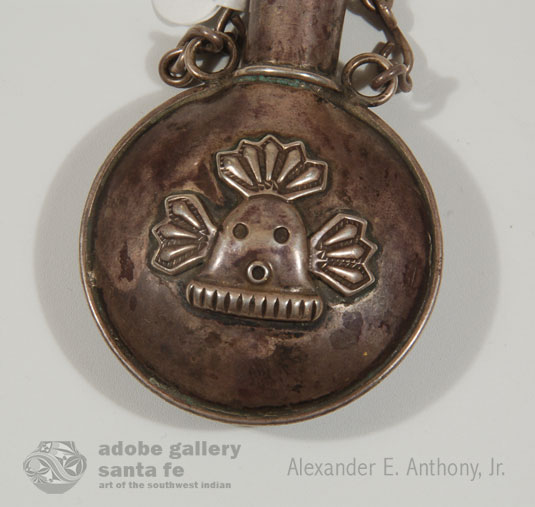Diné – Navajo Sterling Silver Tobacco Canteen with Yei Mask [SOLD]
+ Add to my watchlist Forward to Friend
- Category: Silver Objects
- Origin: Diné of the Navajo Nation
- Medium: silver
- Size: 3-1/2” height x 2-3/8” width
- Item # C3934B SOLD
Silversmithing among the Navajo began sometime in the mid-1800s, possibly during the time of their internment at Bosque Redondo in southern New Mexico. The early days of silversmithing consisted of jewelry items such as bracelets, necklaces and earrings, and the source of silver was most often Mexican silver coins.
By the beginning of the 20th century, ingot silver and then sheet silver became the source of raw materials, and the demands of the buying public became the inspiration for ideas. In addition to making jewelry, the Navajo expanded into more elaborate items such as horse bridles and ketohs (arm bands) for bow hunting. Eventually, they ventured into making flatware, dishes, serving wares, and such things as silver boxes and desk sets.
One of the things primarily made for their own use were tobacco canteens or flasks. They were generally made by attaching two domed stamped silver concha-shaped discs together and attaching a lidded spout, as was this one. Sometimes, turquoise pieces were added.
This flask has a small Navajo Yei Mask on the front. There is shallow stamping on the back that consists of a five-pointed star and radial lines. A handmade double silver chain secures the canteen stopper. The weight of the flask would indicate that it was made from Mexican coin or ingot silver.
Condition: excellent
Provenance: from a client from Colorado
Recommended Reading: Masterworks and Eccentricities: The Druckman Collection; Navajo and Pueblo Jewelry and Metalwork 1880-1950 by Robert Bauver

- Category: Silver Objects
- Origin: Diné of the Navajo Nation
- Medium: silver
- Size: 3-1/2” height x 2-3/8” width
- Item # C3934B SOLD



